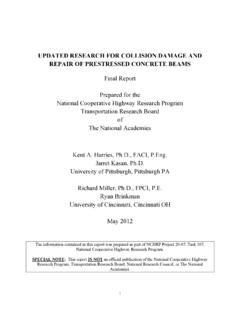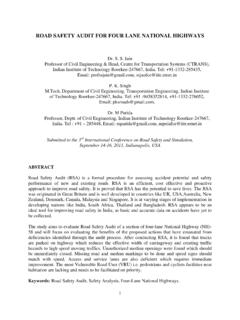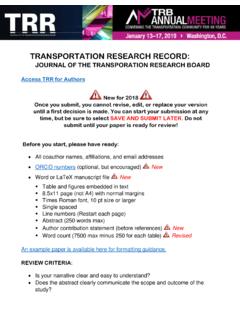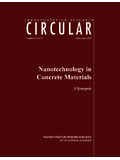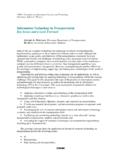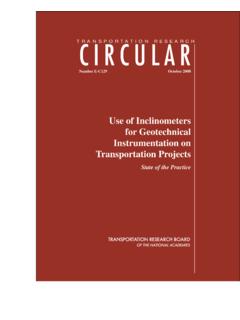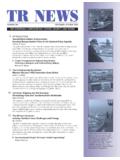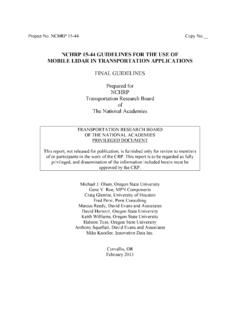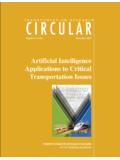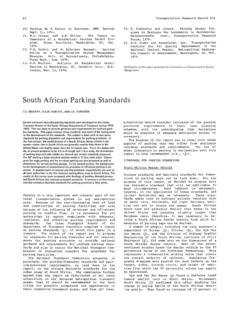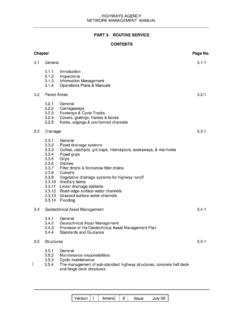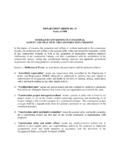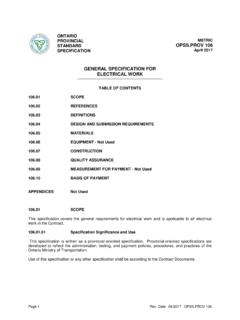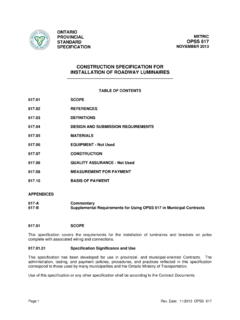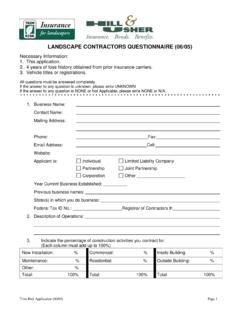Transcription of BEST P IMPLEMENTING UALITY C QUALITY …
1 BEST practices FOR IMPLEMENTING QUALITY . CONTROL AND QUALITY assurance FOR tunnel . inspection . Prepared for: AASHTO Technical Committee for Tunnels (T-20). Prepared by: Gannett Fleming, Inc. 207 Senate Avenue Camp Hill, PA 17011. October, 2009. The information contained in this report was prepared as part of NCHRP Project 20-07, Task 261, National Cooperative Highway Research Program. SPECIAL NOTE: This report IS NOT an official publication of the National Cooperative Highway Research Program, Transportation Research Board, National Research Council, or The National Academies. Disclaimers Acknowledgements This study was conducted for the AASHTO Subcommittee on Bridges and Structures, with funding provided through the National Cooperative Highway Research Program (NCHRP). Project 20-07/Task 261, Best practices for IMPLEMENTING QUALITY Control and QUALITY assurance for tunnel inspection .
2 The NCHRP is supported by annual voluntary contributions from the state Departments of Transportation. Project 20-07/Task 261 is intended to fund quick response studies on behalf of AASHTO Technical Committee for Tunnels (T-20). The report was prepared by Gannett Fleming, Inc. The work was guided by a technical working group. The project was managed by Dr. Waseem Dekelbab, NCHRP Senior Program Officer. Disclaimer The opinions and conclusions expressed or implied are those of the research agency that performed the research and are not necessarily those of the Transportation Research Board or its sponsoring agencies. This report has not been reviewed or accepted by the Transportation Research Board Executive Committee or the Governing Board of the National Research Council. Instructions to Panel Members This project is being conducted for the AASHTO Subcommittee on Bridges and Structures as part of NCHRP Project 20-07/Task 261, Best practices for IMPLEMENTING QUALITY Control and QUALITY assurance for tunnel inspection .
3 The report has not gone through the usual rigorous review process established and monitored by the Transportation Research Board Executive Committee or the Governing Board of the National Research Council, and should not be described as a TRB Report . It should be described as a contractor's report conducted for the AASHTO Technical Committee for Tunnels (T-20) with funding provided through National Cooperative Highway Research Program Project 20-07/Task 261. Table of Contents NCHRP 20-07/Task 261. Best practices for IMPLEMENTING QUALITY Control and QUALITY assurance for tunnel inspection Table of Contents 1. Introduction 2. Current practices for tunnel inspection and Operational Safety/Emergency System Testing 3. inspection Procedures 3. Operational Safety and Emergency Response System Testing 5.
4 Results of Literature Search 12. Recommended Best practices for tunnel inspection 14. QUALITY assurance / QUALITY Control of tunnel Inspections 15. tunnel Inspections Best practices 15. Separate inspection Manuals for Highway and Rail/Transit Tunnels 23. Special tunnel Conditions 23. Recommended Best practices for Operational Safety/Emergency Response System Testing 23. Inspecting and Testing for Operational Safety 23. Inspecting and Testing for Emergency Response 25. Guidelines for Establishing Emergency Response Plans 26. Inventory Data Format 27. tunnel Data Fields 32. Conclusion 33. 1. Introduction Following the 2006 tragic ceiling collapse in the I-90 connector tunnel in Boston, Massachusetts, the National Transportation Safety Board (NTSB) recommended that a mandatory tunnel inspection program be developed to ensure the safety of our tunnels for the traveling public.
5 The NTSB cited a need for improving practices used by state departments of transportation (DOTs). and transportation agencies for inspecting highway tunnels. While there are many different methods for inspecting tunnels, and varying degrees of inspection possible, there is no consistency across the country when it comes to tunnel inspection . In addition, there is limited experience and knowledge of tunnel inspection methods within state DOT's. To initiate a mandatory tunnel inspection program, guidelines are needed which would provide information and standards to enable states to select inspection methods that are most appropriate for their situations. inspection programs should be implemented for regular inventory and condition reporting that will be required as part of the upcoming National tunnel inspection Standards (NTIS) scheduled to be issued by the Federal Highway Administration (FHWA) in 2010.
6 In addition to regular tunnel inspection frequencies for reporting requirements, tunnel owners should also implement inspections from a risk-based analysis approach that considers elements that typically deteriorate or malfunction within the tunnel and the severity of the impact from such problems. This could include inspections when there are major structural defects that could lead to imminent collapse, when structural defects could lead to a loss of serviceability ( water leakage that could cause dangerous conditions for the traveling public), and when there are operational flaws that affect safe passage through the tunnel ( flaws varying from fire safety issues to inadequate lighting to routine traffic flow). Other potential inspections for isolated items can be scheduled when there are periodic closings for minor repairs, replacement of lights, or routine maintenance.
7 tunnel owners may also elect to categorize the various elements and systems to be inspected. Such inspections will involve different personnel based upon the type of inspection to be conducted. Also, appropriate inspection techniques and frequencies can be selected and implemented. Various categories could include: Systems: Structure Elements: Communications Arch Drainage Ceiling slab/architectural panels Fire detection tunnel walls Incident detection Pavement slabs Lighting Pedestrian egress/safe rooms Mechanical/electrical Cross passageways Traffic signals Ancillary spaces Ventilation Portals Processes Emergency response (tow trucks, ambulance, police vehicles). Fire prevention/response Routine closures 2. Miscellaneous Signs Paint/striping tunnel surface condition (paint, tiles).
8 As noted above, there are systems and processes within a tunnel , besides the tunnel structure, that contribute to the overall operational safety within the tunnel . To provide the degree of safety for the traveling public, these systems/processes and the procedures that are followed in the event of an emergency must also be inspected and evaluated periodically. Very little documentation or guidance on this subject exists, and guidelines are needed to implement an overall tunnel inspection program across the country. The research for this report documents current practices for tunnel inspection and for evaluating operational safety and emergency response systems. Recommended best practices are included, including a discussion of QUALITY assurance (QA) measures for inspections, and achieving QUALITY control (QC) of inspection findings.
9 In addition, recommended data fields to be included as part of documenting the tunnel inventory and inspection results are provided. Current practices for tunnel inspection and Operational Safety/Emergency System Testing inspection Procedures The Federal Highway Administration (FHWA) developed a Highway and Rail Transit tunnel inspection Manual in 2003 which was updated in 2005. This document provides guidelines for performing tunnel inspections, including guidance on inspection frequency, inspector qualifications, standardized condition definitions for various types of tunnel construction and equipment, procedures for rating elements within a tunnel , and recommended documentation. This document serves as a good starting point for development of tunnel inspection guidelines and will be discussed further later in this report.
10 The Task 1 Report for this project documented a literature search which detailed the state of the practice for tunnel inspection and included discussion of inspection frequencies, personnel performing inspections, and QC measures that are currently being used in the The literature search was extended also to international tunnel owners to review their latest techniques for performing inspections and current plans to improve inspection results. A survey of highway and rail transit tunnel owners in the was also performed in November 2008 to obtain additional information on the state of the practice for tunnel inspection . 32 highway and 11 transit owners responded to the questionnaire. A brief synopsis of the findings from the Task 1 Report is provided below, from which best practices will be developed later in this report.
